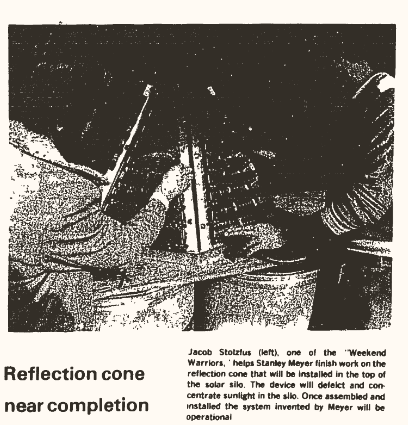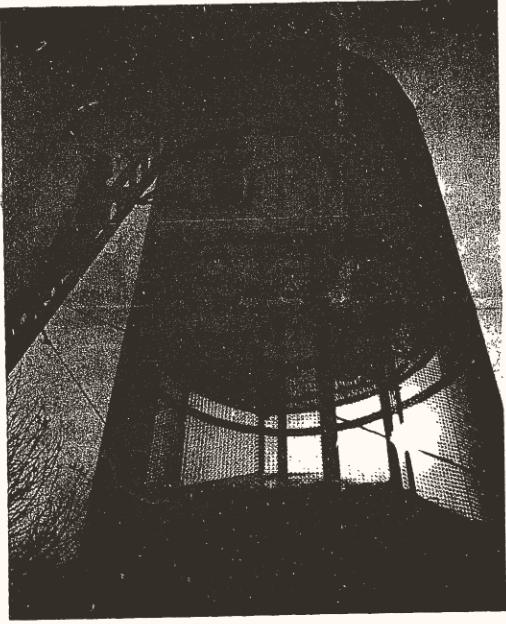Solar Silo - Is it a big hoax, or our last hope? Who will decide? - November 29th, 1979
By STEPHEN OSTRANDER
Record Editor
November 29th, 1979
Source: https://grovecity.advantage-preservation.com/viewer/?k=&t=30203&i=t&d=01011901-12312011&m=between&ord=k1&fn=the_grove_city_record_usa_ohio_grove_city_19791129_english_18&df=1&dt=10
It stands conspicuously beside the home of Charles Hughes, 2222 Marlane Drive, Grove City—this two-story tall translucent solar energy silo. Is it a hoax or will thousands of these energy cells someday supply most of the nation’s energy needs as its inventor claims?
The decision will be made by the American people. It was after all the "public" that endorsed the once-called "hairbrain" schemes of men like Thomas Edison, Henry Ford, Robert Fulton, and Orville and Wilbur Wright.
Inventor Stanley Meyer of Columbus has unwavering faith in the American people, following the examples of their predecessors, will proclaim his solar energy system the "Salvation of the Nation" from its energy crisis. "If not, it might be Meyer's last hope. He's just about exhausted all other sources of support."
Despite being technologically and economically sound, the "self-taught" inventor has not garnered much attention from oil companies, government, and industry. Government wants to keep funding oil research, and Meyer's invention could dramatically reduce the demand for oil.
Who is this man behind the system? A patriot, Meyer has dedicated his invention to the American people. He is staying in America, despite opportunities abroad, because he wants his system to help his country. Basic to the system is the concept of recycling energy by focusing sunlight through a magnifying glass atop a high-rise structure onto a large lens beneath it.
The structure is a silo, which uses giant lenses about one inch thick constructed in a silo-shaped translucent structure to collect sunlight, convert it to energy, and provide enough heat to power the entire home. The solar insulator and superheated steam are designed to power the electrical generator.
Meyer’s demonstration is the 24-foot high silo at 2222 Marlane Drive, which generates 24,000 BTUs of energy from just one day's worth of sunlight. The electrical system would cost under $10,000 to purchase and install.
The silo can also be used to preheat or be made smaller for homes, high-rise buildings, and other commercial structures. Meyer’s system is scalable, and he is confident that this design will revolutionize energy production in America.
Meyer’s invention is based on "new but proven principles." He is confident that it could "pre-pressurize" oil wells so that oil companies can use less equipment in drawing the last 60% of the oil from oil wells.
Meyer has filed for patents with the U.S. Patent Office and refuses to sell his patents to the government, oil companies, or foreign interests. He believes his system can help make the U.S. energy independent.
Patriotism and Christ inspire inventor
 Construction started in February 1975. Meyer, who is assisted by a group of workers he calls the "Weekend Warriors," is 98 percent finished. Completion and installation of the reinforced shield is all that remains to be done.
Construction started in February 1975. Meyer, who is assisted by a group of workers he calls the "Weekend Warriors," is 98 percent finished. Completion and installation of the reinforced shield is all that remains to be done.
The conical focusing lens is one of the key instruments in the silo. Light captured by the plastic lens on the silo is redirected to the electrical build. Unlike conventional solar panels, the efficiency of the new device will not be subject to the angle of the sun’s rays because the silo is rotated and can collect sunlight both morning and evening.
Heat from the redirected rays would be retained in the silo insulator cavity stored in the base of the silo. The heat would boil water and turn it into steam in a heat exchanger, a system of copper pipes. The steam would then drive a steam turbine to power the electrical generator.
Another storage cavity would absorb excess heat for use over extended periods of cloudy weather and at night.
Another advantage of Meyer’s system is its adaptability to mass production. The materials are easily available and inexpensive. The silo also can be easily maintained and modified. Unlike solar panels, which have to be attached to the roof of a home, a solar silo will not require any structural modifications to the home.
The inventor said the silo will remain operational for 20-40 years and will save Americans billions of dollars in fuel costs. Cost of the unit will depend on the size, but Meyer said a home unit measuring 15 feet would cost about $7,500 (although the price might be lower with mass production).
The flat-panel solar energy panels attached to roofs, which are getting national attention, are inferior, Meyer said, because 80-95 percent of the energy is captured by the panels is lost. The solar silo not only captures almost all the sunlight but can produce energy by product-transfer mode (for cloudy days).
Meyer said he has been motivated by Christ and patriotism. He sees the solar silo as his inspiration and seems to symbolize hope and rejuvenation. This, combined with Meyer’s astonishing and frightening figures on America’s large dependence on oil-rich Arab nations, might convince many of the importance of devices such as his that can reduce oil dependence.
About 65 percent of the oil consumed in the U.S. this year will come from the Middle East, Meyer said, an increase of 33 percent from 1975. Americans might buy as much as $200 billion in oil in 1980, which was the same amount paid for Arab oil from 1965-1975.
As a result, Arab oil producers have had the means to buy controlling interests in every American oil and utility company, Meyer said. When he found out companies like Turkish Associates in Delaware were behind Arab investments in U.S. energy, he was disturbed.
Government and industry, which have been tied to the interests of oil-rich nations, are backing the solar panel device, Meyer said, because they know solar panels won’t solve America’s energy problems. Even if he uses flat panels, the U.S. consumer will still have to use oil to provide all his energy needs, the inventor said.
Meyer tried to get government support for his project. Personal letters to President Gerald Ford and Ohio Governor James Rhodes went unanswered. The Federal Energy Administration (now the Department of Energy) told Meyer it was only interested in flat plate ideas.
Private industry’s response was not more flattering. Those offers would have put restrictions on the system’s development or Meyer would have sold the patents.
Pressure was even felt locally. A Columbus firm hired to make parts for the silo refused to deliver Meyer’s parts, saying they thought "no one else was interested." Except for The Record and one Columbus television station, Meyer said, the media has not expressed any interest in his invention.
Meyer believes his solar silo can reduce the price of gas, drought, apathy, and guilt associated with the energy crisis. In other words, patriotism, promises, and faith in America.
“I feel my system is divinely inspired, and that the grace of God will be in this project to allow its operation in a very short length of time,” Meyer said in conclusion.
The inventor now is confident spring will be the completion date of the silo, and before or perhaps ushering in a revolution—one relying on sunlight rather than gunpowder.

